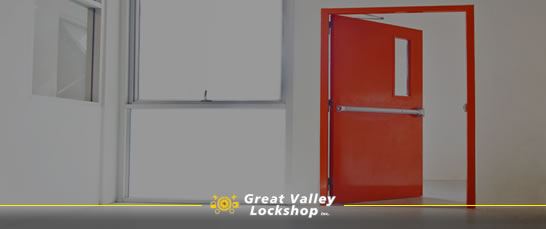
Staying Up to Code with Doors & Hardware for Healthcare
When caring for ill or injured patients, it’s important to make sure they have a safe environment to recover and heal. In particular, health care facilities like hospitals and nursing homes have to do everything they can to protect against the risk of fire.
The key to proper fire safety is carefully following the fire code and standards. Unfortunately, they can be confusing and difficult to understand because it’s possible that a single facility has to follow the requirements of different Authority Having Jurisdictions (AHJs).
The most common AHJs are the National Fire Protection Association (NFPA), the International Building Code (IBC), and the Centers for Medicare and Medicaid Services (CMS). At times, reconciling the codes of these different AHJs can be a challenge, but there are some essential points that can help clarify the issue.
History
Although there are fire code standards for many different elements of a building, one of the most important areas of consideration is door openings.
Today’s safety regulations emerged in response to past health care facility fires. One of the most tragic examples occurred at Hartford Hospital in Connecticut. The fire broke out on December 8, 1961, and led to the deaths of seven patients, five visitors, and four staff members.
This event perfectly demonstrates the important role that doors and hardware can play in an emergency. In fact, one of the reasons the fire was so deadly was a hardware failure on one of the doors in the south corridor. After this fire and others like it, investigators were able to learn a lot about what improvements could be made to current and future facilities in order to better protect everyone inside.
Door & Hardware Codes that Apply to Medical Settings
Doors
When considering safety standards for door openings, the first aspect to evaluate is the door itself.
Corridor Doors
According to NFPA 101 – Life Safety Code (LSC), most corridor doors in health care facilities are not required to comply with NFPA 80 – Standard for Fire Doors and Other Opening Protectives, which gives the requirements for fire door assemblies.
This includes patient room doors and double-egress doors, which swing open in opposite directions. However, even though they aren’t required to be fire-rated, there are still standards for these doors that facilities must follow.
- Doors must be constructed to resist the passage of smoke.
- The clearance between the bottom of the door and floor covering can be no more than 1 inch.
- The door must be constructed from 1 3/4-inch solid bonded-core wood or materials that resist fire for at least 20 minutes.
Smoke Barriers and Fire-Rated Doors
In addition to these requirements, there are specific doors in health care facilities that must be fire-rated, including those leading to exit enclosures like stairwells. Other possibilities include doors going into hazardous and incidental use areas, like laboratories and linen collection rooms.
One of the most common circumstances where a door must be fire-rated is when it is part of a smoke barrier. These are dividers used to create compartments within the building and prevent the movement of smoke. They are essential features of health care facilities because patients can be transported from one compartment to another until it’s possible to evacuate. The IBC requires smoke barriers to have a 1-hour fire-resistance rating and a 20-minute-rated fire door assembly.
Additional requirements for all fire-rated doors include that they must be self-closing or automatic closing without louvers or transfer grilles. Gasketing, however, is not necessary if the door is sufficiently tight-fitting in the frame.
Hardware
One of the greatest dangers of the fire at Hartford Hospital was that the pressure created by the fire in the south corridor caused the rolling door latches to release, making it very difficult to keep the door closed.
To prevent this kind of situation from happening again, roller latches are no longer allowed by NFPA 101 in almost all cases. The only exceptions are places like acute psychiatric settings where this type of latch, which uses friction bolts that hold the door in a closed position, is necessary for the safety of patients.
Instead of roller latches, corridor doors must now have positive latching hardware. This means that they self-latch when closed and remain closed against the pressure of a fire. Likewise, any pair of doors must have constant-latching flush bolts. This is a requirement of both CMS and IBC.
Related article: Learn about Contactless Entry & Security Solutions for Healthcare.
Where to Find Doors and Hardware for Healthcare
Great Valley Lockshop can answer all of your questions about fire-safe doors for health care facilities to ensure that you get the best possible commercial security product at the right price. We’re committed to helping you create a compliant and safe environment for your patients, visitors, and staff. Call Great Valley Lockshop today!








